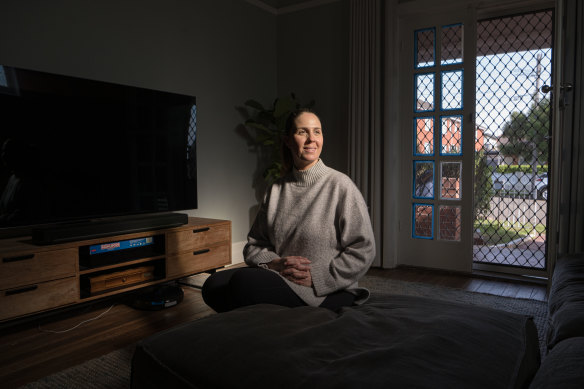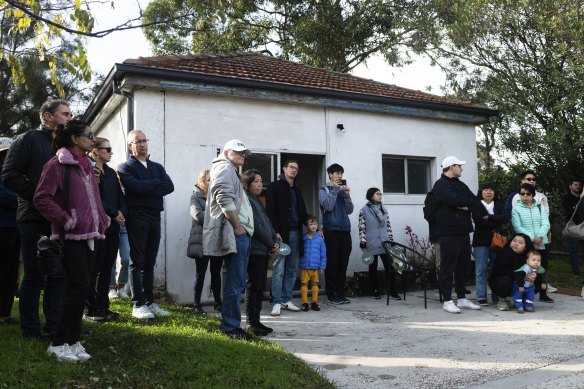This was published 1 year ago
The Sydney suburbs where house prices have risen the least in five years
Samantha Hassan bought a house that had one less bedroom, was far older and cost $200,000 more than a nearby home that sold five years ago.
Since 2019, Hassan and her husband have been faced with not only rising prices but also rising mortgage rates that left them almost priced out of Drummoyne, even though it was one of the weakest-growing suburbs in that time. In fact, the weakest 20 suburbs in Sydney all still recorded increases.

Samantha Hassan and her husband spent almost three years looking for to buy in Drummoyne even though it was one of the weakest growing suburbs since 2019.Credit: Flavio Brancaleone
“When we first started looking, our pre-approval was just under $2.4 million, and then six months ago, our pre-approval was $1.4 million,” said the 36-year-old who works in events. “It wasn’t just the [rising] market, but it was also [rising] interest rates.”
Despite two downturns in that period, including Drummoyne’s 9.3 per cent slide in the past year to March, Hassan said it made little difference to their home-buying aspirations as the suburb remains 24.3 per cent higher than five years ago.
“We honestly got lucky. What was so hard over that time was everything we wanted was just out of reach. When your borrowing power doesn’t improve, the price makes no difference.”
It has been a common story for most home buyers in Sydney in the past five years to March 2024, as even the weakest-performing housing markets still recorded increases.
Even the slowest growing suburb, Kingsford, rose 14.8 per cent to a median house price of $2,353,000. It was followed by a range of even less desirable and more far-flung suburbs that recorded steeper growth despite small declines in the past year.
Rising prices were compounded by an unprecedented pandemic and the fastest rate hikes in a generation, leaving the average home buyer behind if they were hoping to get into a house in any pocket of Sydney in the ensuing five years.
Domain chief of research and economics Dr Nicola Powell said Sydney’s property market is more expensive than five years ago. House prices rose 57 per cent in that time.
“There are no suburbs that have fallen over the past five years because we’ve seen house prices have made a full recovery,” Powell said. “What that shows at a suburb level is the lift is broad-based.”
Meanwhile, units had recorded declines that were down by 22 per cent in Kingswood to -2.5 per cent in Strathfield in the bottom 20 suburbs. Powell said it highlighted Sydneysiders’ strong preference for houses.
“It showcases the strength in the house sector, part of that is we’ve seen weaker or slower growth in units by comparison,” Powell said.
St George chief economist Besa Deda said Sydney’s broad-based house price growth was driven by low interest rates for some of the period, until the first hike in May 2022, and an ongoing undersupply of housing.
“A shortage of dwellings, strong population growth and market expectations that the next move in interest rates are a powerful mix of factors that are supporting growth in dwelling prices and likely to see dwelling prices supported over the period ahead.”

House prices haven’t fallen in any suburb of Sydney over the past five years. Credit: Rhett Wyman
Deda said that while she is not expecting price growth to continue at the same rate as last year because of affordability and borrowing capacity constraints, prices were likely to continue rising due to demand and undersupply of housing.
“It means that potential home buyers may move towards more affordable areas further away from the coast and the CBD, for example, or from areas that have good access to infrastructure and transport to relatively more affordable areas,” she said.
“It includes potential home buyers considering apartments over a house with a backyard, and it may mean looking at homes that contain more confined living spaces.”
The Agency Inner West and Drummoyne’s Fayez Yammine said it was undoubtedly harder to buy property in his pocket of Sydney than in 2019 despite concerns that never materialised.
“I remember 2019 was quite a tough market because there were talks just before the election of the Labor Party getting in,” Yammine said. “The market went really flat because of the potential of negative gearing being abolished and talks of interest rates going up if the Labor Party got in.”
Instead, the Liberal Party won the federal election, rates were cut and held at a record low of 0.1 per cent, the pandemic hit and inflation reached its highest level in decades triggering the 13 rate hikes since 2022 – the fastest in a generation.
“It’s much harder [to buy now],” Yammine said.